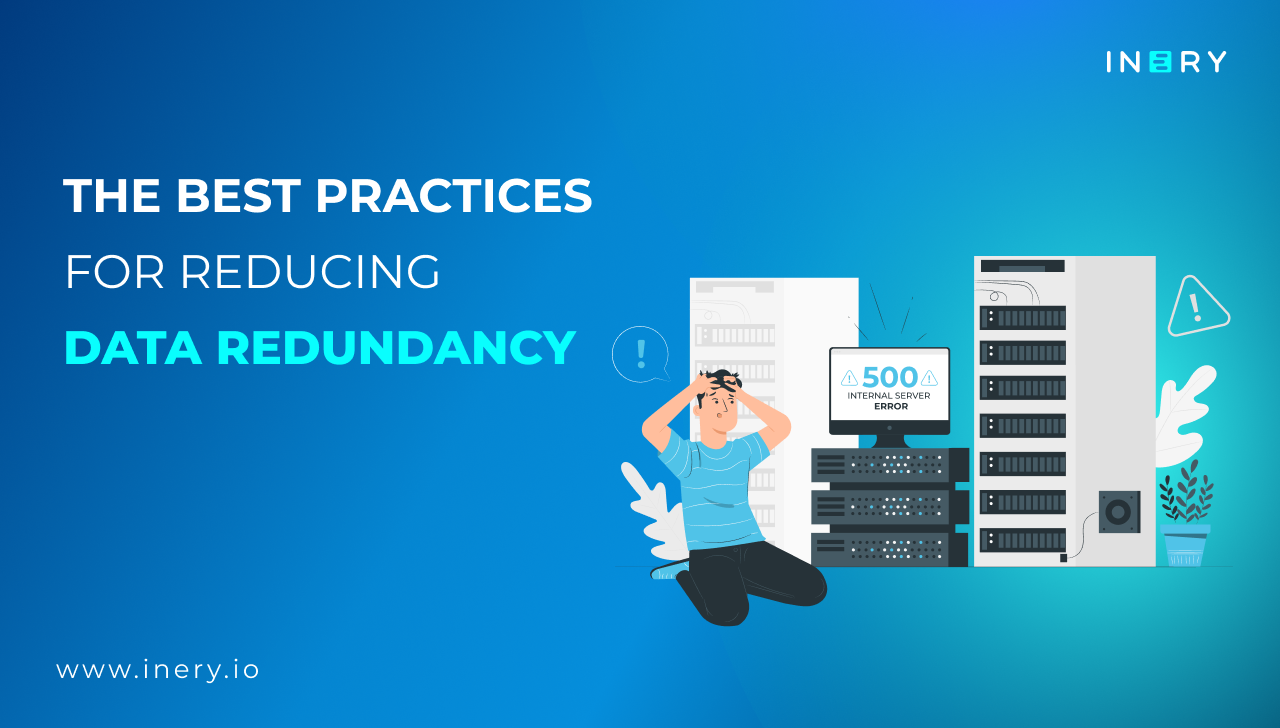In an era where the relentless pursuit of optimization has become a hallmark of both personal and professional success, individuals and businesses alike are continually striving to streamline their operations. It's no surprise that this drive for efficiency extends to the realm of data management. After all, as data has emerged as a cornerstone of modern decision-making – optimizing its handling has become paramount.
One of the central challenges organizations face is the specter of data redundancy – the issue of maintaining duplicate copies of the same data in multiple locations. Data redundancy, though often unnoticed, carries substantial consequences. It inflates storage costs, strains system resources, and introduces an inherent risk to data integrity and consistency.
Historically, centralized database systems have stood as the tried-and-true solution for data management. But let's pause for a moment and delve into the world of data redundancy – what exactly is it, and why is it considered a challenge?
In this article, we will delve into the intricacies of data redundancy, gaining a clear understanding of what it entails, why it's harmful, how it functions, and how to successfully reduce it. We'll also delve into the evolving landscape of database management, where decentralized database systems have quietly emerged as a promising alternative.
Data Redundancy: Why It Matters and How It Works
Data redundancy is the practice of storing the same data in multiple locations. It might seem harmless, but it carries substantial implications. It inflates storage costs, strains system resources, and introduces a lurking threat to data integrity and consistency.
In other words, data redundancy is like having multiple copies of the same information scattered around, causing all sorts of headaches. Let’s imagine a large multinational corporation with offices scattered worldwide. Each regional branch keeps its own set of customer data, product inventories, and sales records.
But here's the catch: data redundancy starts to make a mess of things. Customer names, contact details, and purchase histories end up being stored in different ways across all these databases.
This isn't just confusing; it's like throwing marketing efforts out the window and missing valuable sales opportunities. Worse yet, when the company tries to figure out things like sales trends or how satisfied their customers are, it's like trying to put together a jigsaw puzzle with pieces missing and others showing up twice.
1. Normalize Your Database
Normalization is a time-tested technique in the realm of database design that deserves a closer look. When we talk about normalizing a database, we mean organizing it into smaller, well-structured tables, each containing specific information. This process usually involves dividing a large table into smaller ones, which are then linked together using keys.
This approach ensures that data is stored efficiently, with minimal duplication. Normalization follows a set of rules known as normal forms, including the first normal form (1NF), second normal form (2NF), and so on. Each normal form comes with its own set of criteria, ensuring that data remains consistent and that redundancy is minimized.
For instance, 1NF dictates that each table must have a primary key, while 2NF requires that non-key attributes are dependent only on the primary key. The beauty of normalization is that it not only reduces data redundancy but also simplifies data retrieval and maintenance. It makes databases easier to manage and helps maintain data integrity by ensuring that updates or changes are made in one place.
2. Embrace Decentralized Database Management
Decentralized database management systems (DDBMS), such as Inery, are gaining momentum as a viable solution to address data redundancy issues. These systems operate on a fundamentally different principle than traditional centralized databases. In a DDBMS, data is distributed across a network of nodes or servers, with each node being responsible for storing and managing its share of the data.
By decentralizing data, organizations can effectively reduce data redundancy. No longer is the same data stored in multiple places; instead, each node stores only the data it needs to operate. This approach not only minimizes redundancy but also enhances data security and resilience. If one node fails, the network can still function, as the data is distributed across multiple locations.
Furthermore, decentralized systems usually leverage blockchain technology, which adds an extra layer of redundancy reduction. Blockchain is an immutable ledger where each transaction is recorded in a secure, transparent, and tamper-proof manner. Once data is written to the blockchain, it cannot be altered or duplicated without consensus from the network participants, ensuring data integrity.
3. Implement Data Deduplication
Data deduplication is an effective technique for identifying and eliminating duplicate data entries within a dataset. It can be applied in both centralized and decentralized database management systems. Deduplication processes typically involve scanning data to identify identical records or chunks and then removing the redundant instances. In the context of decentralized systems, data deduplication becomes even more powerful.
Since each node manages its data independently, it's easier to identify and eliminate redundancy across the network. This process not only saves storage space but also reduces the chances of data inconsistencies caused by duplicated information.
Data deduplication can be implemented using specialized software tools, which automatically detect and remove duplicates. Some systems also employ data fingerprinting or hashing techniques to quickly identify identical data chunks. Deduplication contributes to efficient storage and data transfer, making it a valuable tool in the fight against data redundancy.
4. Leverage Distributed Ledger Technology
Decentralized database management systems often rely on distributed ledger technology (DLT), with blockchain as a prominent example. Blockchain's attributes of transparency, immutability, and decentralization make it a powerful tool for reducing data redundancy. In a blockchain, data is stored across a network of nodes, with each node containing a copy of the entire ledger. Transactions are recorded in a transparent and secure manner, with cryptographic links ensuring that once data is entered, it cannot be altered or duplicated without consensus from the network participants.
Blockchain's immutability ensures that once data is written, it remains unchanged, eliminating the risk of data redundancy caused by multiple versions of the same information. Furthermore, the decentralized nature of blockchain means that there is no central point of control, reducing the likelihood of data loss due to a single point of failure.
5. Automated Data Validation
Automation is a crucial aspect of modern data management, especially in the context of reducing data redundancy. Automated data validation processes can maintain data consistency and prevent redundant information from entering the system. In decentralized systems, automation can be achieved through smart contracts, which are self-executing contracts with predefined rules. These contracts automatically validate and enforce data standards, ensuring that only data that adheres to predefined criteria is accepted.
For instance, a smart contract can verify the uniqueness of certain data fields, preventing the insertion of duplicate records. By automating data validation, organizations can not only reduce data redundancy but also ensure data accuracy and consistency. Smart contracts can operate independently across the network, providing a reliable layer of data validation and enforcement.
Inery: The Best Practice for Data Redundancy
As we've delved into the intricate world of data redundancy, exploring its challenges and various techniques to mitigate it, it becomes evident that modern data management is evolving. With data redundancy posing such a significant concern, developers and organizations are actively seeking innovative solutions to streamline their data operations. This is where Inery steps into the spotlight as a prime exemplar of how cutting-edge technology is transforming the data management landscape.
Inery is not just a decentralized database management system; it's a comprehensive solution that directly addresses the issue of data redundancy, offering developers and organizations a path toward more efficient and secure data handling. In an era where every byte of data matters, Inery empowers users to take control and revolutionize the way they store, access, and utilize their data.
By embracing the decentralized philosophy, Inery eradicates the age-old problem of data redundancy by distributing data across a network of nodes, ensuring that each piece of information is stored only once, in one place. No longer do organizations need to grapple with the intricacies of multiple copies of data scattered across various locations. This streamlined approach not only minimizes data redundancy but also strengthens data security and resilience.

Inery•
2 years ago
An Overview of IneryDB: Decentralized Database Management Solution
Addressing the concerns persisting in the centralized and distributed infrastructure. ...READ MORE

Share

Inery•
2 years ago
Advisor Spotlight — Bally Singh
A web 3.0 marketing wizard and an ingenious entrepreneur join as an advisor of Inery. ...READ MORE

Share

Inery•
10 months ago
Decoding Data Mining: What You Should Know and How to Stay Clear
Explore the world of data mining, its impact on your privacy, and how to shield your data from unwanted scrutiny in this comprehensive guide. ...READ MORE

Share

Inery•
8 months ago
How to Optimize SQL Query With Multiple Joins: 9 Great Tips
For the best tips on how to optimize SQL query with multiple joins, check out this actionable guide. ...READ MORE

Share
Most popular today


-1665070349.png)
-1700735858.png)